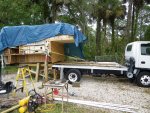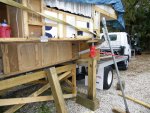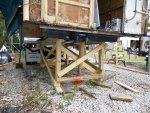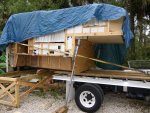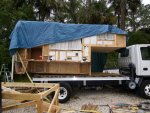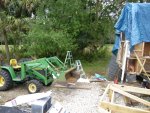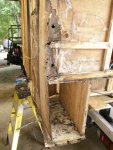john101477
Photographer in the Wild
Looks like it is coming together really nice Vic. The aluminum bed is kind of neat. where they able to set up mounting locations for the camper?
I just got back from a 3000 mile trip in the FE (6 spd. auto) and averaged 10.4 mpg with a scooter on the front bumper and 7 more on a trailer behind. Drove down the Oregon Coast and through the Redwoods......to Las Vegas then back through Northern Nevada and Idaho
most semi trucks with dual tanks just connect the drain fitting on the bottom of each tank with a hose and treat it as one big fuel tank.
because we travel rough roads / off road we were afraid that a low hanging hose might rip off on something and strand us with no fuel.
we connected the supply hose on each tank and the supply hose to the engine to a 3 way valve. we also connected the return hose on each tank and the return line from the engine to another 3 way valve so each tank is isolated and all the hoses are up high.
all we have to do to switch tanks is to turn both valves from one tank to the other.
I'm in Aus. I bought mine about 3 years ago from US company website - no longer exists.Gait - How much does the Pollack valve cost? I couldn't find it for sale anywhere.
We thought of using the drain fitting. I don't really expect to be in too rough terrain with it as it is only 2WD, but keeping the tanks isolated from each other might be wise.
Hi Vic,
You can do this. If you want to just T them together, you will need to fit a ball valve on each drain fitting so you can isolate either tank if needed. Make really sure of the run between the tanks though. You may even need to run a bar across to support the hoses. The hiccup might be that the tailsahft is right about the same height as the drains meaning you could possibly go around the front of the engine rather than go under the shaft????? Hey, you'll have to check that yourself on the truck. The T and the whole length of the bridging hose has to stay as low as the drains or it won't work properly when it gets towards the bottom but sure.......it's a simple system and some prefer to have the tanks drain evenly to keep the weight level and I've even seen this setup with only one gauge in one tank as they will balance out. The isolation valves usually end up being used only in an emergency situation anyway.
Remember all those Pollak valves are 12 volt too. Well at least all the ones we get here are. Not 24v like you NPR so you'll have to reduce the voltage somewhere along the line. No problem with switching the gauge signal though AND they have 10mm & 8mm ports (or whatever that is in English....3/8" & 5/16", I think). The fuel lines on your NPR are probably 12mm & 10mm so you'll need some brass barbed and stepped joiners. The last thing you want is air leaks. Don't worry about theoretical reduced flow through the valve. It never bothers them.
John.
U.S. NPRs are 12v, not 24,
God bless, Vic
